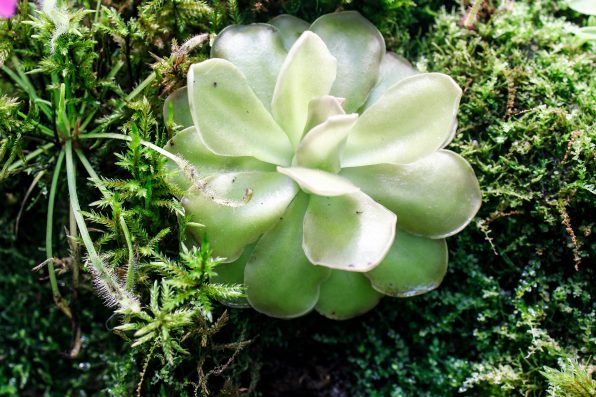Forget About The Venus Flytrap: Have You Ever Heard Of This Meat-Eater Known As Butterwort?

When it comes to predatory plants, the Venus flytrap is the most famous one of them all. TikToker Rosanne Becker (@rosannebecker) is introducing you to another lesser-known meat-eater found in the plant world–the tropical butterwort.
Butterworts, or pinguicula, are small succulents that produce rosettes of flat green leaves. The leaves have a greasy, buttery feel to them. The foliage is also sticky, which is how the plant traps gnats, flies, mosquitoes, and other small insects.
They even have a slight sweet smell, which is what helps attract the insects. The glands in the leaves secrete an acidic liquid that dissolves the bugs and is absorbed by the plant.
The carnivorous plant grows in the northern hemisphere as well as in Central and South America. Mexico is where the widest variety of species can be found.
Butterworts are not hard to take care of. However, they do have very specific growing requirements. In addition, there are two different types of butterworts–temperate and tropical. They may also have different needs.
For tropical butterworts, water them with low mineral water. Rosanne advises against using tap water unless you know for certain that it’s low mineral. Distilled water, rainwater, or reverse osmosis water are suitable alternatives to low mineral water.
They don’t like soil that is excessively wet, so make sure you don’t overwater your plant. Rosanne uses a squirt bottle to dampen the soil, being careful not to get the leaves wet. Water until the liquid starts draining out of the bottom of the pot. You don’t need to water it again until the top layer of the soil appears crusty and dry.
The soil should be of a type that retains moisture and is fast-draining. Rosanne uses a sandy soil mix that is one part peat moss and two parts perlite. Fertilizer is not necessary for the butterwort’s growth.
As for lighting, it is recommended to place your butterwort in a south-facing window or in a location where it can soak up a few hours of direct sunlight in the mornings and bright, indirect light for the rest of the day. Rosanne keeps her butterworts near an east-facing window, but since her home does not receive much sunlight, she supplements it with a grow light.

elenarostunova – stock.adobe.com- illustrative purposes only
Finally, butterworts are not poisonous to cats or dogs, but Rosanne notes that just like any other non-toxic houseplant, your pet can become sick if they consume a lot of it.
@rosannebecker Replying to @ssamflowers I’ve only been growing butterworts for a couple of years so I’m still a noob, but I’m happy to share what I’ve been doing to keep mine alive. #CarnivorousPlant #Butterwort #Pinguicula #PlantTikTok #plantsoftiktok #planttok #Plants #PlantTips #PlantCare
If true crime defines your free time, this is for you: join Chip Chick’s True Crime Tribe
She’s Talking About What Dating Was Like For Her Growing Up Amish
Get Boo-zy With These Beautiful Halloween Wine Glasses
How To Grow And Care For Black Huckleberries, Which Are Perfect For Making Baked Goods And Jams
Sign up for Chip Chick’s newsletter and get stories like this delivered to your inbox.
More About:Gardening





